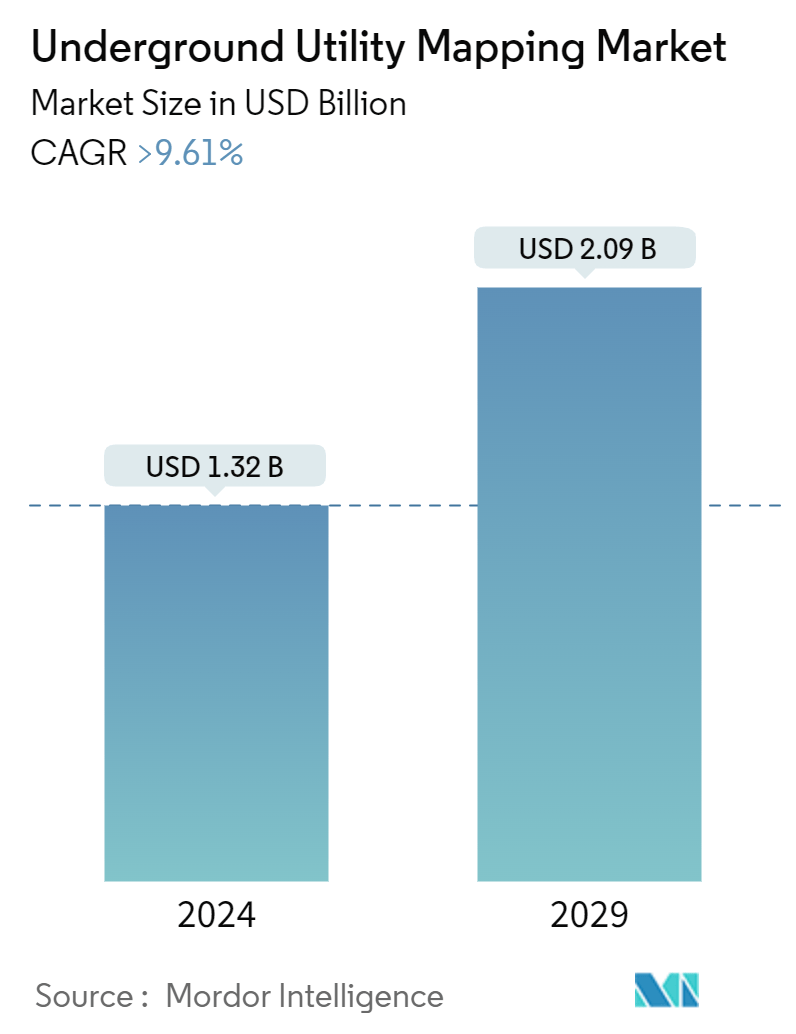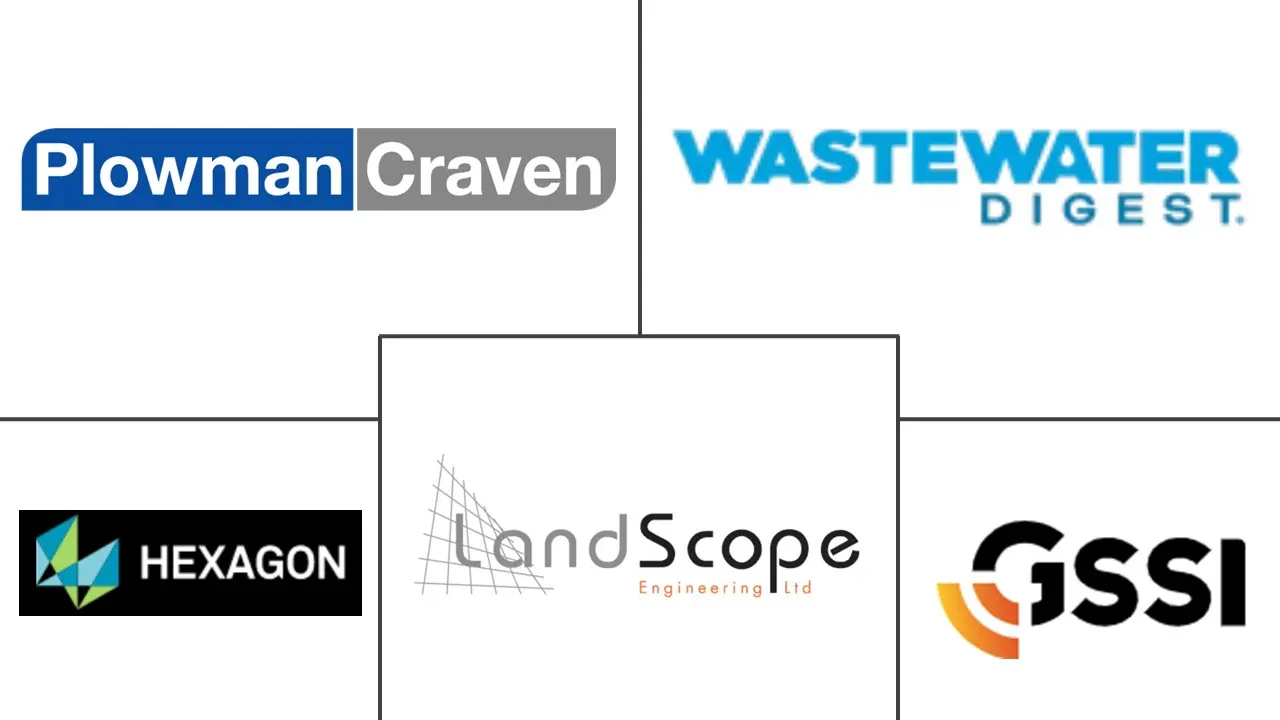Market Size of Underground Utility Mapping Industry

| Study Period | 2019 - 2029 |
| Market Size (2024) | USD 1.32 Billion |
| Market Size (2029) | USD 2.09 Billion |
| CAGR (2024 - 2029) | 9.61 % |
| Fastest Growing Market | Asia Pacific |
| Largest Market | North America |
Major Players
*Disclaimer: Major Players sorted in no particular order |
Underground Utility Mapping Market Analysis
The Underground Utility Mapping Market size is estimated at USD 1.32 billion in 2024, and is expected to reach USD 2.09 billion by 2029, growing at a CAGR of greater than 9.61% during the forecast period (2024-2029).
Underground utility mappings like pipework or underground electric wires determine the utility location. Underground utility mapping is essential to civil engineering because it saves time and money on costly repairs caused by striking utilities. Project planners can accurately plan costs for work to be done with the help of an accurate utility map. However, surveyors face record accuracy and mapping challenges, as mapping the location of hidden utility objects is an inherently difficult task.
- Over the last few years, the subsurface utility engineering (SUE) industry has developed novel approaches to mapping underground utility infrastructure. Geophysical technologies such as electromagnetic locators and ground-penetrating radars are used with non-technical methods such as historical records to gather sufficient subsurface infrastructure information.
- With the proliferation of smartphones in recent years, vendors are seizing the opportunity to create app-based mapping solutions to aid engineers in their work. For example, Radiodetection, a manufacturer of underground utility mapping tools, released an Android mapping app compatible with the RF marker locator range and the cable, pipe, or RF marker range. The app uses Bluetooth connectivity to create a real-time map of buried utilities.
- The combination of emerging technologies with utility maps is revolutionizing the underground utility mapping market by improving the accuracy, efficiency, and safety of exploration activities. These advancements enable exploration teams to overcome challenges associated with underground infrastructure, optimize exploration routes, and minimize risks, ultimately driving growth and innovation in the market.
- Technological advancements have led to the development of sophisticated detection applications that are more accessible to many users. These applications may include software solutions, mobile apps, and handheld devices equipped with sensors capable of detecting underground utilities.
- High maintenance costs often accompany high upfront investment requirements for mapping tools. This can deter potential customers, especially smaller organizations or those with limited budgets, from adopting underground utility mapping solutions.
- The COVID-19 pandemic accelerated the adoption of digital technologies, including underground utility mapping solutions. Organizations recognized the importance of digitizing and automating processes to improve efficiency, reduce reliance on manual labor, and mitigate future disruption.
Underground Utility Mapping Industry Segmentation
Accurate information on existing underground utilities is required to plan and install new utilities and excavate existing utilities. The subsurface utility mapping market scope tracks the adoption of various solutions and services used by multiple end-use industries such as electricity, public safety, building and construction, oil and gas, telecommunication, etc. The report also focuses on the effects of the pandemic on the ecology of the utility mapping market. The scope includes the existing vendor landscape for significant market players.
The underground utility mapping market is segmented by component type (solutions and services), by end-user industry (public safety, oil and gas, building and construction, telecommunication, electricity, and other end-user industries), and by geography (North America, Europe, Asia-Pacific, the Middle East and Africa, and Latin America).
| By Component Type | |||||
| |||||
| Services |
| By End-user Industry | |
| Public Safety | |
| Oil and Gas | |
| Building and Construction | |
| Telecommunication | |
| Electricity | |
| Other End-user Industries |
| By Geography*** | |
| North America | |
| Europe | |
| Asia | |
| Australia and New Zealand | |
| Latin America | |
| Middle East and Africa |
Underground Utility Mapping Market Size Summary
The underground utility mapping market is experiencing significant growth, driven by the increasing need for accurate and efficient mapping solutions in civil engineering and infrastructure development. This market is essential for preventing costly repairs and project delays caused by accidental utility strikes. The industry has seen advancements in subsurface utility engineering, utilizing geophysical technologies like electromagnetic locators and ground-penetrating radars, alongside historical records, to enhance mapping accuracy. The integration of emerging technologies, such as app-based solutions and GPR-enabled drones, is revolutionizing the market by improving the precision, efficiency, and safety of utility mapping activities. These innovations are particularly crucial in densely populated urban areas, where the complexity of underground infrastructure demands precise mapping to avoid disruptions during construction.
The market is characterized by a semi-consolidated structure, with both global players and small to medium-sized enterprises competing for market share. Key players are engaging in strategic partnerships and acquisitions to enhance their offerings and maintain a competitive edge. The COVID-19 pandemic has accelerated the adoption of digital technologies in the sector, highlighting the importance of digitizing and automating processes. North America, in particular, is witnessing a surge in demand for underground utility mapping services due to rapid urbanization and smart city initiatives. The region is also focusing on data sharing methods to improve infrastructure management. As the market continues to expand, the combination of advanced technologies and strategic collaborations is expected to drive further growth and innovation in underground utility mapping solutions.
Underground Utility Mapping Market Size - Table of Contents
-
1. MARKET INSIGHTS
-
1.1 Market Overview
-
1.2 Industry Attractiveness - Porter's Five Forces Analysis
-
1.2.1 Threat of New Entrants
-
1.2.2 Bargaining Power of Buyers/Consumers
-
1.2.3 Bargaining Power of Suppliers
-
1.2.4 Threat of Substitute Products
-
1.2.5 Intensity of Competitive Rivalry
-
-
-
2. MARKET SEGMENTATION
-
2.1 By Component Type
-
2.1.1 Solutions
-
2.1.1.1 Ground Penetrating Radar
-
2.1.1.2 Electromagnetic Locators
-
2.1.1.3 Other Solutions
-
-
2.1.2 Services
-
-
2.2 By End-user Industry
-
2.2.1 Public Safety
-
2.2.2 Oil and Gas
-
2.2.3 Building and Construction
-
2.2.4 Telecommunication
-
2.2.5 Electricity
-
2.2.6 Other End-user Industries
-
-
2.3 By Geography***
-
2.3.1 North America
-
2.3.2 Europe
-
2.3.3 Asia
-
2.3.4 Australia and New Zealand
-
2.3.5 Latin America
-
2.3.6 Middle East and Africa
-
-
Underground Utility Mapping Market Size FAQs
How big is the Underground Utility Mapping Market?
The Underground Utility Mapping Market size is expected to reach USD 1.32 billion in 2024 and grow at a CAGR of greater than 9.61% to reach USD 2.09 billion by 2029.
What is the current Underground Utility Mapping Market size?
In 2024, the Underground Utility Mapping Market size is expected to reach USD 1.32 billion.

